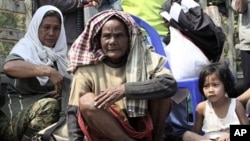The Thai-Cambodia border is at an uneasy calm after recent deadly clashes near disputed territory left several people dead and scores injured. Thousands on both sides have fled the area. The fighting led to a dramatic drop in the number of tourists and traders crossing the border.
At the Chong Jom market on the Thai-Cambodia border, Cambodian shopkeeper Kaew Yungurn squeezes auto polish onto a rag. He demonstrates his product for a couple journalists and onlookers on a sample piece of a car hood.
As he works, Kaew says sometimes you have to apply two coats of the white liquid, which cost $6 a bottle. But now he shows how it can repair minor scratches.
Unfortunately, the normally busy market that brings together Thai and Cambodian traders is almost empty and Kaew has no customers.
When fighting between Thai and Cambodian troops broke out last Friday, hundreds of shops were abandoned as people fled for safety.
On Wednesday, most shops remained closed.
Kaew says he wants both sides to hold talks so he can get back to business as soon as possible.
At the Chong Sangum immigration checkpoint, the number of people crossing the border has dropped from 50 to fewer than 10 a day.
Immigration Bureau Deputy Commissioner Pansak Kasemsant says there have been no tourists since Friday.
He says the number of tourists decreased because of the unclear situation. But actually, he says, there is no fighting here. The place where the problem occurs is 90 kilometers from this checkpoint.
The clashes erupted near disputed territory surrounding a 900-year-old Hindu Khmer temple known as Preah Vihear in Cambodia and Phra Viharn in Thailand.
Thailand and Cambodia have soldiers stationed near the temple, leading to occasional exchanges of fire.
The weekend fighting was the worst in years with both sides shooting artillery and machine guns.
Several people were killed, scores injured, and thousands of villagers fled the border.
In 1962, the International Court ruled the temple lies in Cambodia, but a key access point is in Thailand. A dispute over the border near the access point lay dormant for decades, until in 2008, when the United Nations granted the temple World Heritage status, at Cambodia’s request.
The designation angered some Thai nationalists, and there have been periodic military clashes around the area since then. Disputes over other parts of the border also have flared up.
In Bangkok, a group of nationalists is holding a protest around the main government offices. They demand that Thailand abandon a memorandum of understanding it signed with Cambodia in 2000 on settling border disputes.
Despite the tensions, at least one group of Thai visitors on Wednesday crossed into Cambodia.
Thaveesilp Suvwattana is a history professor at Thailand's Mahasarakham University.
He is taking his master's degree students to learn about Thailand and Cambodia's shared culture and history.
"If you want to know about Thai history, [as] part of that you should know about Cambodia, the Khmer, I can say Khmer history, too, because they used to control our land in Thailand, you know, before. And a lot of things, ruins, things, and other things, you know, just come from Khmer culture," he said.
Thaveesilp says the border dispute is about politics and nationalism with people on both sides interpreting history for their own hidden political agendas.
He says Thailand and Cambodia should accept the past, move on from historical disputes, and hold talks to build a peaceful future as neighbors.
Slideshow of Refugees













